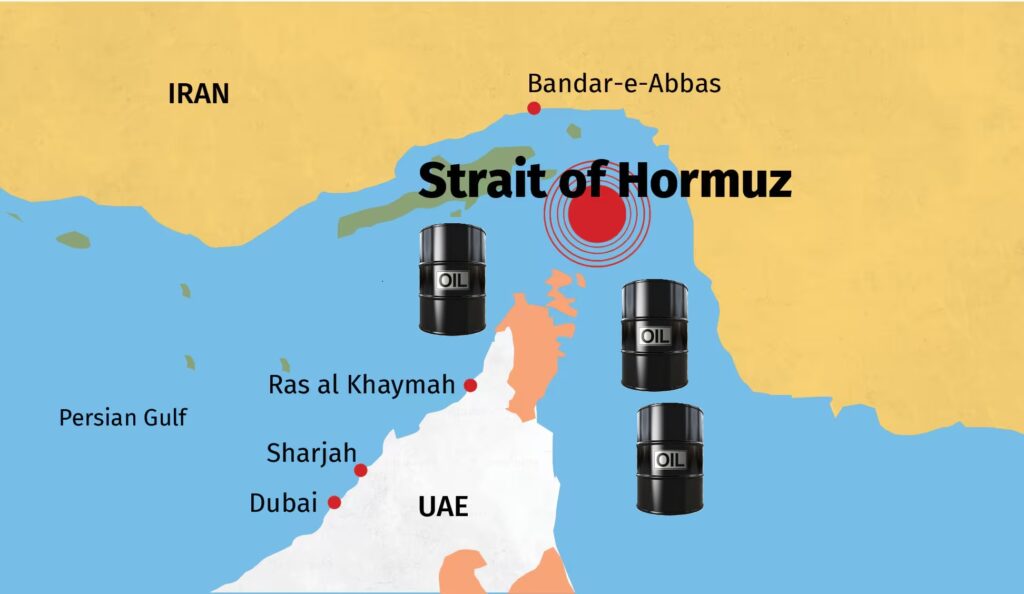Why the Strait Is Dominating Today’s Headlines
-
Fresh flashpoint in the Iran-Israel conflict: A U.S.–Israeli strike on Iranian nuclear sites (22 June) has pushed Tehran’s leaders again to threaten a blockade of the Strait of Hormuz.
-
Tanker collision adds jitters: Two oil tankers, Adalynn and Front Eagle, collided on 17 June only 28 km off the UAE coast. Security firms say it wasn’t sabotage, but the incident highlights the narrow waterway’s vulnerability.
-
Market reaction: Brent shot to a five-month high; Goldman Sachs now predicts that crude oil prices could temporarily rise to $110–$120 per barrel if the flow through the strait is even partially disrupted.
What Makes Hormuz Irreplaceable
| Fast facts | Details |
|---|---|
| Width at choke point | 33 km navigable channel, only ~2 km each way |
| Daily throughput (2024) | 20 million bpd crude & condensate – ~20 % of global consumption |
| LNG share | About ⅕ of world’s LNG, mostly from Qatar |
| Key stakeholders | Iran, Oman, UAE territorial waters; policed by US Fifth Fleet & CTF-150 |
India’s Exposure: 47 % of All Crude Imports
India imports ~5.5 million bpd of crude, and roughly 2 million bpd—about 47 % of the total—sail through Hormuz. Any blockage would reverberate through pump prices, the rupee, and inflation.
Potential price shock: Indian refiners could face landed crude at $100–150/bbl, inflating the country’s oil import bill by up to $9 billion per month at peak stress levels, according to Bloomberg consensus estimates and EIA flow data.
Could Iran Close the Strait?
Tehran has laid detailed contingency plans: fast-attack craft, mini-subs, and floating mines. Analysts note, however, that an airtight blockade would take weeks to establish and would risk rapid U.S. naval retaliation.
The Few (Costly) Work-Arounds
-
Saudi East-West Pipeline – 5 m bpd to Red Sea, but often half-utilised.
-
UAE Habshan-Fujairah Pipeline – 1.8 m bpd direct to the Gulf of Oman.
-
Iran’s Goreh-Jask Line – 0.3 m bpd effective, small, and intermittent.
Even if all three ran flat-out, they would only offset about 20 % of the crude normally shipped through Hormuz.
What Delhi Is Doing (and What More It Can Do)
| Action | Status & Effect |
|---|---|
| Strategic Petroleum Reserve drawdowns | 5.3 m tonnes available (≈10 days cover) – buys time, not immunity. |
| Diversify the import basket | Extra barrels from Russia, the U.S., and West Africa help but are longer, costlier routes. |
| Boost pipeline diplomacy | India–UAE talks on extending Fujairah capacity; proposals remain on paper. |
| Fuel efficiency & alternative energy push | Medium- to long-term buffer, minimal near-term relief. |
Outlook: A Narrow Channel, A Wide Shadow
With prediction markets now pricing a one-in-two chance of a closure in 2025 and risk premiums already flowing into Brent, the Strait of Hormuz remains the world’s most consequential maritime bottleneck. For India, where every second litre of petrol begins its journey through this 33-km funnel, keeping those sea lanes open is not just a foreign-policy priority; it’s an economic imperative.
Stay tuned: we’ll continue to track naval deployments, Iranian parliamentary activity, and tanker traffic data to update you if conditions change.

